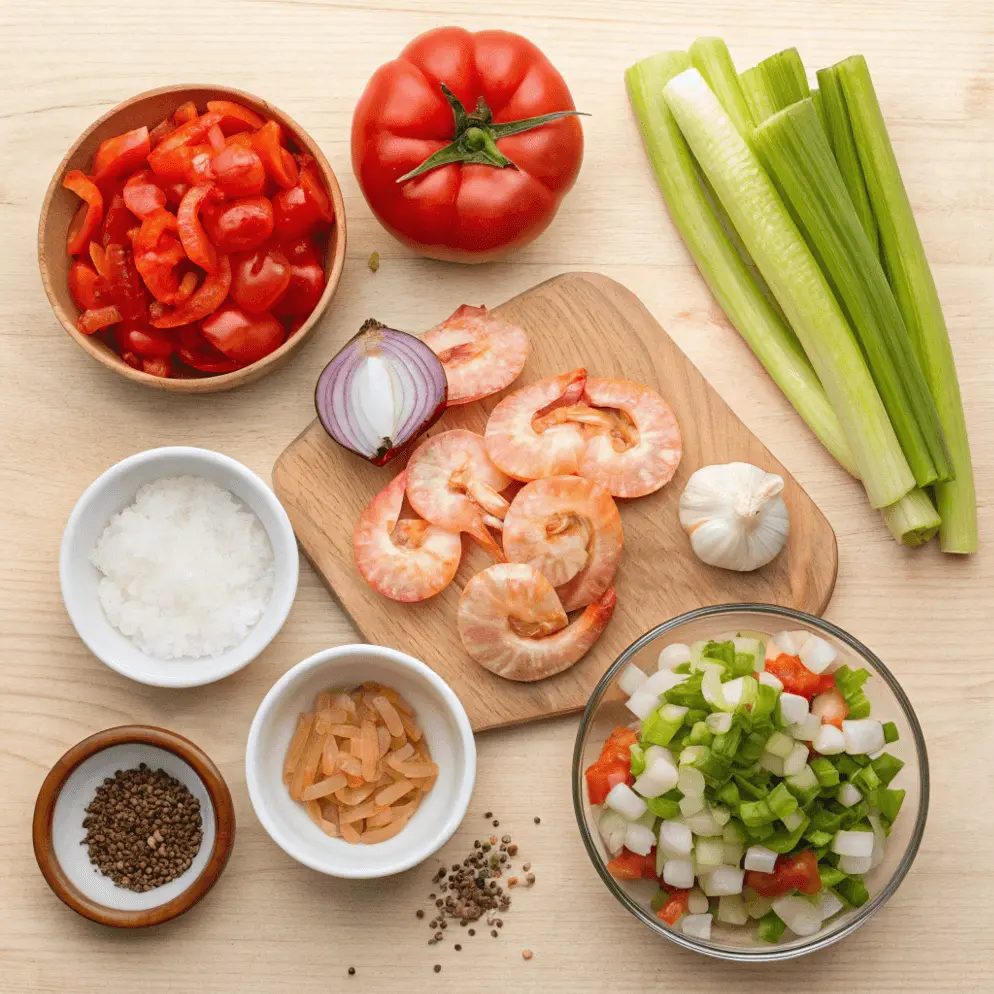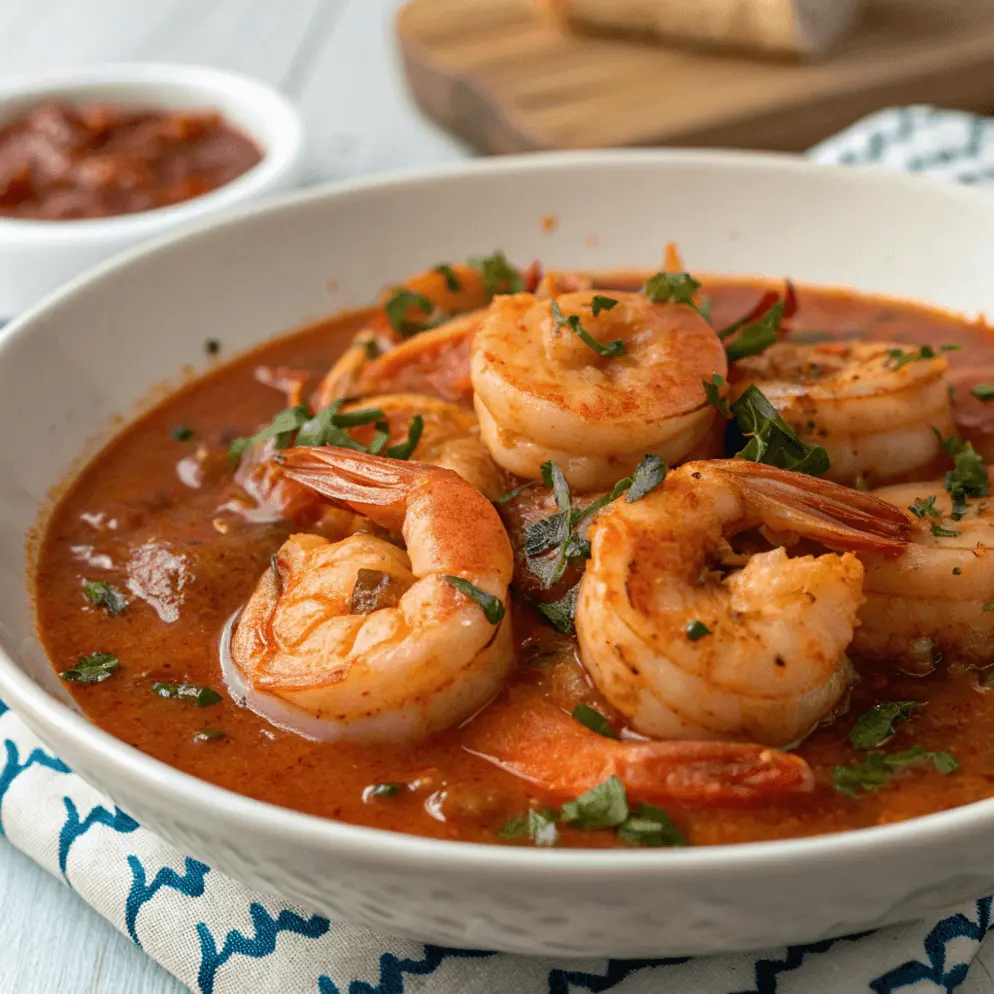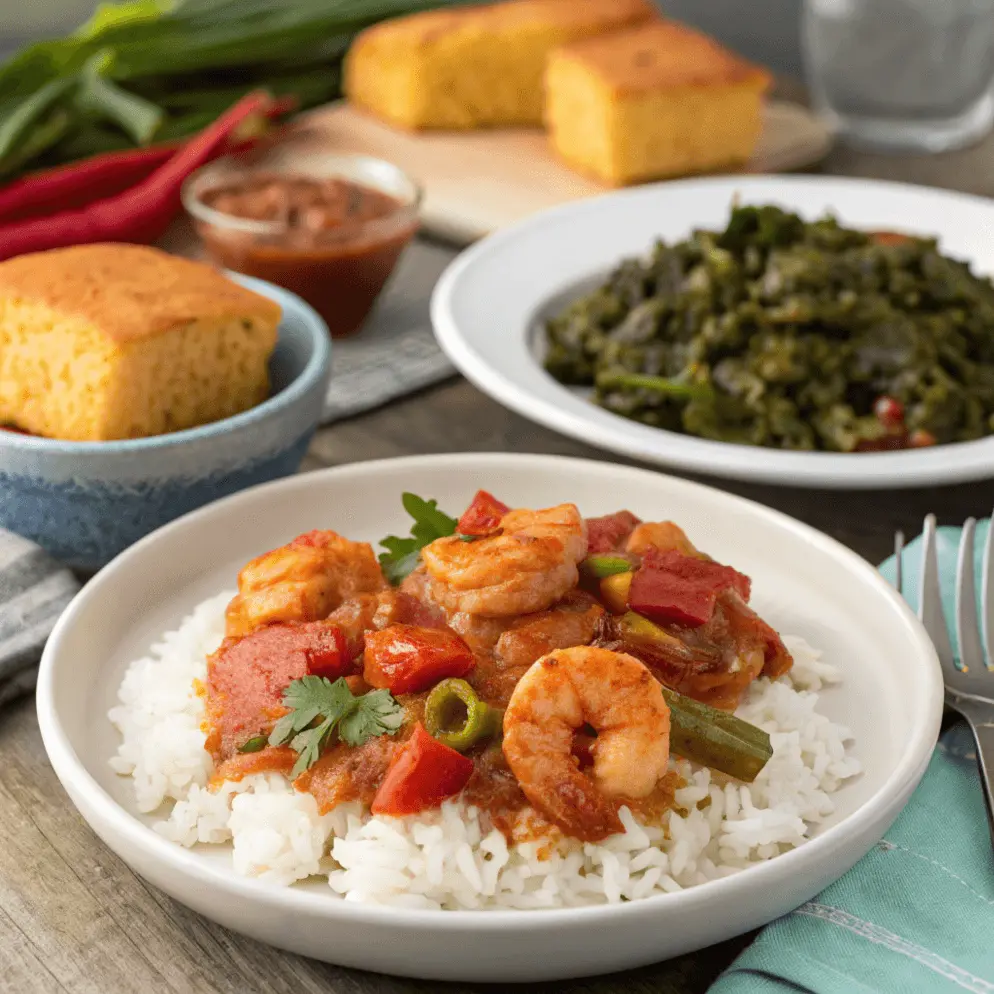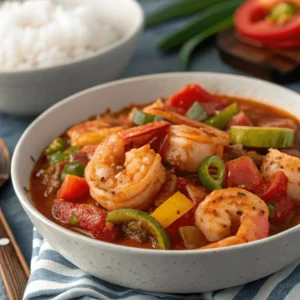Louisiana shrimp creole recipe isn’t just another shrimp dish—it’s a bold, comforting Southern classic that brings the vibrant flavors of New Orleans straight to your kitchen. Made with tender shrimp simmered in a rich, tomato-based Creole sauce and served over rice, this dish is a celebration of culture, spice, and slow-cooked goodness.
In this complete guide, you’ll discover everything you need to create the perfect shrimp creole—from understanding its Louisiana roots to mastering the traditional ingredients that define its unmistakable flavor. Whether you’re new to Southern cooking or a longtime fan of Creole cuisine, this easy-to-follow recipe brings together heat, heart, and heritage in every bite.
You’ll also find step-by-step instructions, expert cooking tips, storage advice, creative variations, and answers to the most common questions home cooks ask about shrimp creole.
Table of Contents
What Is Louisiana Shrimp Creole and Why Is It So Popular?
What Defines a Traditional Louisiana Shrimp Creole Recipe?
A Louisiana shrimp creole recipe is the kind of Southern dish that tells a story with every bite. It’s bold, hearty, and simmered with tradition. At its core, this recipe combines plump shrimp with a tomato-rich Creole sauce filled with vibrant spices, vegetables, and herbs—then served hot over fluffy white rice. It’s a go-to favorite across Louisiana homes, especially in New Orleans and the Gulf Coast region.
Key elements in an authentic Louisiana shrimp creole recipe include:
- Shrimp – wild-caught Gulf shrimp preferred for their flavor and texture
- Creole sauce – a tomato-based mix of onions, bell peppers, celery (the “Holy Trinity”), and garlic
- Seasonings – cayenne, thyme, paprika, bay leaves, Worcestershire sauce
- Rice – white rice acts as the classic bed for soaking up that bold sauce
Unlike thicker Cajun stews or gumbos, this dish uses no roux. The result? A saucy, spiced shrimp entrée that’s as vibrant in color as it is in flavor.
The Roots of Creole Cooking in Southern Louisiana Cuisine
Creole cooking is deeply tied to Louisiana’s unique cultural melting pot. French, Spanish, African, and Caribbean traditions shaped the bold flavors that define Louisiana shrimp creole recipes today. Originating in the port city of New Orleans, shrimp creole evolved as an urban adaptation of home-cooked seafood stews using local ingredients and global influences.
Unlike rustic Cajun dishes, Creole meals lean on fresh tomatoes, fine herbs, and a more balanced spice blend. This explains why shrimp creole is a favorite across generations—it’s refined yet simple, and endlessly customizable.
Why this recipe still stands out:
- It celebrates authentic Louisiana cooking
- It’s quick enough for weeknights, but rich enough for holidays
- It’s a great way to highlight fresh or frozen shrimp in a bold, comforting sauce
Want more Southern favorites? Try our swamp soup recipe for another taste of Deep South flavor that’s easy to prepare and perfect with cornbread.
If you’re looking for a dish that blends culture, flavor, and comfort, the Louisiana shrimp creole recipe is a classic that delivers every time.
Key Ingredients for Authentic Shrimp Creole Flavor

A truly authentic Louisiana shrimp creole recipe is all about building bold, layered flavor using simple, fresh ingredients. Whether you’re cooking it for the first time or perfecting a family recipe, it all starts with choosing the right elements.
Essential Ingredients Used in a Louisiana Shrimp Creole Recipe
At the heart of every traditional Louisiana dish is a balance of flavor, texture, and spice. Here’s what you’ll need for a classic shrimp creole:
| Ingredient | Purpose in the Dish | Notes |
|---|---|---|
| Shrimp | Star protein, sweet and tender | Use large Gulf shrimp if available |
| Crushed Tomatoes | Base of the Creole sauce | Can substitute with tomato sauce or diced tomatoes |
| Onion | Part of the flavor base (“Holy Trinity”) | Yellow or white onions are best |
| Bell Pepper | Adds sweetness and aroma | Green is traditional, but red or yellow work too |
| Celery | Earthy balance to other vegetables | Don’t skip—it’s essential to the Southern base |
| Garlic | Boosts aroma and flavor depth | Fresh garlic is key |
| Bay Leaves | Subtle earthy depth | Remove before serving |
| Cayenne & Paprika | Bring heat and smokiness | Adjust to taste |
| Thyme & Oregano | Adds herbal notes | Fresh or dried both work |
| Worcestershire Sauce | Adds umami and body | A small splash goes a long way |
| Chicken Stock | Rounds out the sauce | Low-sodium preferred to control saltiness |
| White Rice | Traditional serving base | Long-grain rice preferred for light, fluffy texture |
Using fresh ingredients whenever possible is the key to getting that from-scratch Creole taste.
Don’t miss our creamy crab brulee recipe for another seafood twist with bold, layered flavor.
The Role of the Holy Trinity: Onion, Bell Pepper, and Celery
If you’ve ever heard someone from Louisiana talk about the “Holy Trinity” in cooking, they’re not referring to religion—they’re talking about onion, bell pepper, and celery. This trio forms the foundation of any Louisiana shrimp creole recipe.
Why It Matters:
- These three vegetables form the aromatic base that flavors the entire dish.
- They’re sautéed first to soften and release flavor before other ingredients are added.
- This combination is to Louisiana what mirepoix is to French cuisine.
For best results, chop the trinity into uniform pieces so they cook evenly and dissolve seamlessly into the sauce.
Looking for more ways to cook with Gulf Coast flavors? Explore our best gluten-free crab cake recipe—another Southern favorite with big seafood flavor.
With these ingredients in your kitchen, you’re already halfway to Creole greatness. The rest comes down to how you build the dish—one aromatic, simmering layer at a time.
How to Make Louisiana Shrimp Creole (Step-by-Step Instructions)
This is where your Louisiana shrimp creole recipe comes to life. The beauty of this dish is in its layers—first the sautéed aromatics, then the rich tomato base, and finally the succulent shrimp that ties it all together. You don’t need to be a chef to master it, just follow each step with care and attention to timing.
Prepping the Shrimp and Base
Before you build the sauce, prep your shrimp and aromatics. Using fresh or frozen shrimp is fine, just make sure they’re peeled and deveined.
Shrimp Prep:
- Rinse and pat dry
- Remove shells and tails (optional)
- If using frozen shrimp, thaw completely in cold water
- Season lightly with salt, pepper, and a pinch of paprika
Base Prep (The Holy Trinity):
- Dice 1 medium yellow onion
- Dice 1 green bell pepper
- Chop 2 celery stalks
- Mince 3 garlic cloves
Sauté these vegetables in 2 tablespoons of butter or oil over medium heat for about 5–7 minutes until softened and aromatic.
Building the Sauce and Layering Flavors
Now it’s time to create the flavorful tomato-based sauce that gives this Louisiana shrimp creole recipe its signature taste.
Sauce Building:
- Add seasonings:
- 1 teaspoon paprika
- ½ teaspoon cayenne (adjust to spice preference)
- 1 teaspoon dried thyme
- 1 teaspoon oregano
- 2 bay leaves
- Add liquids and tomatoes:
- Stir in 1 tablespoon tomato paste and cook for 1 minute
- Add 1 can (14.5 oz) crushed tomatoes
- Add 1 cup low-sodium chicken broth
- Splash in 1 tablespoon Worcestershire sauce
- Bring to a gentle simmer
- Simmer uncovered for 20 minutes, stirring occasionally, until sauce thickens slightly and flavors develop
Looking for other Louisiana classics? Try our southern cornbread recipe—a perfect companion to this saucy shrimp dish.
Simmering and Serving Over Rice
This last step is quick—shrimp cook fast, so timing is key.
- Add shrimp to the simmering sauce
- Cook for 5–7 minutes until the shrimp turn pink and opaque
- Taste and adjust salt, pepper, or spice as needed
- Remove bay leaves
Serving:
- Spoon hot shrimp creole over steamed white rice
- Garnish with chopped green onions or fresh parsley
| Step | Time | Notes |
|---|---|---|
| Sauté vegetables | 5–7 mins | Until soft and aromatic |
| Simmer sauce | 20 mins | Thickens and deepens in flavor |
| Cook shrimp | 5–7 mins | Shrimp should be pink and just cooked through |
Craving more seafood-based comfort? Check out our smoked salmon brine recipe to expand your Southern seafood repertoire.
This step-by-step process ensures you capture every layer of flavor in this classic louisiana shrimp creole recipe, resulting in a dish that’s balanced, hearty, and deeply satisfying.
Pro Tips for Cooking Perfect Shrimp Creole Every Time

Even the most authentic louisiana shrimp creole recipe can go wrong if you miss a few key details. From shrimp texture to spice levels, mastering the small things makes all the difference. Below, we break down expert tips that ensure every bite of your shrimp creole is perfectly cooked and deeply flavorful.
How to Avoid Overcooking the Shrimp
Shrimp cook quickly—usually in under 7 minutes—and overcooked shrimp can ruin the texture of your entire dish. They should be tender and juicy, not rubbery.
Tips for Shrimp Perfection:
- Cook shrimp last: Only add them once the sauce is fully developed
- Don’t leave them in the pot after cooking: Turn off the heat and remove the pan from the stove to prevent residual cooking
- Look for visual cues: Shrimp are done when they turn opaque and curl into a loose “C” shape
- Use medium to large shrimp: They hold their texture better in hot sauce
Want more protein options? Discover how flavor holds in rich sauces with our chicken bone broth recipe.
How to Balance the Heat and Spices in Creole Dishes
Heat is a signature part of Creole cooking, but it should never overpower the dish. A well-balanced Louisiana shrimp creole recipe lets the spice enhance—not dominate—the sauce.
Adjusting the Spice Like a Pro:
- Start with ½ teaspoon cayenne and taste before adding more
- Use paprika for color and mild warmth
- Add hot sauce to individual servings instead of the whole pot
- Balance strong heat with a touch of sugar (¼ teaspoon) or a splash of lemon juice to round out flavor
- For milder versions, swap cayenne with smoked paprika
| Spice Control Tip | Why It Works |
|---|---|
| Add heat in small amounts | Lets you dial in just the right spice level |
| Taste as you cook | Keeps you in control of balance and saltiness |
| Use fresh herbs if possible | Adds brightness and balances rich tomato flavors |
For a family-friendly variation, learn how to tone down spice in sauces in our bison chili recipe.
Getting your shrimp just right and managing heat levels carefully are the two pillars of a standout louisiana shrimp creole recipe. When those details are handled with care, the result is nothing short of Southern comfort in a bowl.
Louisiana Shrimp Creole vs. Other Southern Dishes
The South is rich in culinary traditions, and while shrimp creole holds a special place on the Louisiana table, it’s often confused with similar dishes like shrimp étouffée or gumbo. Understanding the differences helps you appreciate what makes a louisiana shrimp creole recipe truly unique.
Shrimp Étouffée vs. Shrimp Creole – What’s the Difference?
Though both dishes use shrimp and are rooted in Louisiana’s culinary history, they differ in flavor, texture, and technique.
| Feature | Shrimp Creole | Shrimp Étouffée |
|---|---|---|
| Sauce Base | Tomato-based | Roux-based (buttery and thick) |
| Spice Profile | Brighter, more tomato-forward | Richer, smokier, slightly deeper in flavor |
| Thickness | Medium consistency | Thicker and creamier |
| Typical Veggies | Onion, celery, bell pepper (Holy Trinity) | Same, but cooked in butter-based roux |
| Serving Style | Over rice | Over rice or grits |
| Visual Appearance | Red-hued sauce | Light brown or golden-brown |
Shrimp creole focuses on acidity and spice from tomatoes and herbs, while étouffée delivers richness from a slow-cooked roux.
Cajun vs. Creole: Flavor, Ingredients, and Cooking Style
People often use “Cajun” and “Creole” interchangeably, but they represent distinct food cultures in Louisiana.
Key Differences:
- Creole cuisine (like this shrimp creole recipe) is more urban, uses tomatoes, and is associated with New Orleans
- Cajun cuisine is more rural, built around smoked meats, dark roux, and deep spice layers
| Element | Creole Cuisine | Cajun Cuisine |
|---|---|---|
| Tomatoes | Common in dishes like shrimp creole | Rarely used |
| Herbs & Spices | Balanced mix of fresh and dried | Heavier on spice blends |
| Protein | Seafood, chicken, sausage | Often includes game meats or smoked meats |
| Origin | French/Spanish-African-Caribbean fusion | French-Acadian rural settlers |
Want a unique Southern fusion? Try our chicken piccata meatballs for a Cajun-style twist with a comforting base.
A true louisiana shrimp creole recipe stands apart because it merges Creole elegance with down-home comfort. It’s lighter than étouffée, more refined than Cajun stews, and totally unforgettable when done right.
Variations and Customizations of Shrimp Creole
The beauty of a Louisiana shrimp creole recipe is its flexibility. While the traditional version is rooted in Creole heritage, home cooks across the South (and beyond) have adapted it in countless creative ways.
Using Sausage, Chicken or Tofu in a Shrimp Creole Recipe
If you’re short on shrimp or looking to mix it up, there are several delicious protein alternatives that still work beautifully with the tomato-based Creole sauce.
- Andouille sausage – Adds a smoky, spicy twist. Brown the slices first before building your sauce.
- Chicken thighs or breast – Use cooked, shredded chicken for a richer, protein-packed option.
- Tofu or tempeh – Great for vegetarian versions. Use firm tofu, pressed and pan-seared for texture.
- Mixed seafood – Add crab, crawfish, or scallops to enhance the Creole seafood medley.
Want more unique seafood spins? Try our best gluten-free crab cake recipe for another delicious way to enjoy coastal flavor.
Making It Low-Sodium, Gluten-Free, or Low-Carb
Shrimp creole is already naturally gluten-free and easy to modify for dietary preferences. With a few swaps, your Louisiana shrimp creole recipe can fit almost any lifestyle.
| Dietary Need | Smart Substitutions |
|---|---|
| Low-Sodium | Use no-salt-added tomatoes and homemade stock |
| Gluten-Free | Serve over cauliflower rice or gluten-free grains |
| Low-Carb/Keto | Skip rice and serve over sautéed zucchini noodles |
| Vegan | Swap shrimp for mushrooms or tofu, and use veggie broth |
| Dairy-Free | This dish is naturally dairy-free—no changes needed |
Curious about other lighter, protein-rich alternatives? Explore our chicken apple sausage recipes for more flavorful, health-conscious options.
With so many ways to adapt this dish, it’s easy to make your louisiana shrimp creole recipe work for any table—whether it’s weeknight family dinner or a festive occasion with guests.
What to Serve with Louisiana Shrimp Creole

While a Louisiana shrimp creole recipe shines on its own, the right side dishes and pairings can take it to the next level. Whether you’re hosting a dinner party or cooking up a casual weeknight meal, the goal is to complement the dish’s bold, spicy, tomato-rich flavors with sides that offer balance, contrast, and Southern soul.
Classic Southern Side Dishes That Pair Perfectly
Pairing shrimp creole with the right sides keeps the meal grounded in Southern tradition and lets the flavors sing.
Top Side Dish Ideas:
- White rice – The most traditional base, perfect for soaking up the sauce
- Cornbread – Adds a mildly sweet, crumbly texture that balances out the spice
- Fried okra – Crunchy and earthy, a Southern classic alongside any Creole main
- Coleslaw – Light and refreshing, cools the palate between spicy bites
- Green beans or collard greens – A hearty, fiber-filled vegetable side that complements the richness
Want something sweet after all that savory spice? Try our creamy crab brulee recipe for an unforgettable seafood dessert twist.
Whether you’re keeping things casual or going full-on festive, these pairings complete the experience of a true Louisiana shrimp creole recipe and showcase the richness of Creole food culture.
How to Store, Reheat and Freeze Shrimp Creole
A good louisiana shrimp creole recipe is not only delicious fresh—it also stores and reheats well, making it a great option for meal prep or leftovers. With a tomato-based sauce and quick-cooking shrimp, it’s important to handle this dish properly to maintain both food safety and flavor.
Best Storage Practices for Leftovers
If you’ve got leftovers, you’re in luck—Creole flavors tend to deepen overnight. Just be sure to store everything the right way.
| Storage Method | Duration | Notes |
|---|---|---|
| Airtight in fridge | 2–3 days | Ideal for next-day meals |
| In glass containers | Preferred | Won’t stain like plastic |
| Separate rice/sauce | Recommended | Maintains better texture and flavor |
Planning meals for the week? Don’t miss our smoked salmon brine recipe for another seafood-based prep option that holds up beautifully in the fridge.
Freezing Tips and Reheating Without Overcooking Shrimp
Yes, you can freeze shrimp creole—but shrimp are delicate, so freezing and reheating must be done with care.
How to Freeze Shrimp Creole:
- Let the dish cool completely before freezing
- Portion into freezer-safe containers
- Label with the date and freeze for up to 1 month
- For best results, freeze without the rice
How to Reheat:
- Thaw overnight in the refrigerator
- Reheat gently over medium-low heat on the stovetop
- Stir often to prevent the sauce from separating
- Avoid microwaving on high—this overcooks the shrimp
- Add a splash of chicken broth if the sauce has thickened too much
Need more freezer-friendly seafood ideas? Check out our seafood boil recipe for a make-ahead Southern seafood feast.
Handled right, your Louisiana shrimp creole recipe can taste just as amazing the next day—or even weeks later—giving you more value from every batch.
Frequently Asked Questions
What ingredients are in shrimp Creole?
A traditional shrimp Creole includes Gulf shrimp, crushed or diced tomatoes, onions, bell peppers, celery (the “Holy Trinity”), garlic, Creole seasoning, cayenne pepper, thyme, bay leaves, and Worcestershire sauce. It’s typically served over white rice and simmered into a bold, spicy tomato-based sauce.
What is the difference between shrimp etouffee and shrimp Creole?
The key difference lies in the base and texture. Shrimp Creole is made with a tomato-based sauce and has a thinner consistency. Shrimp étouffée uses a rich roux (butter and flour) base, creating a thicker, creamier gravy. Étouffée also tends to be more Cajun in flavor, while shrimp Creole reflects Creole culinary traditions with tomatoes and herbs.
What are some common mistakes when making Creole shrimp?
One of the most common mistakes is overcooking the shrimp, which makes them rubbery. Other errors include not sautéing the vegetables long enough to release flavor, using too much heat that overpowers the sauce, and failing to let the sauce simmer to develop depth. Always cook the shrimp at the end and taste as you go for balance.
What is creole sauce made of?
Creole sauce is a tomato-based sauce made with sautéed onions, bell peppers, celery, garlic, herbs (like thyme and oregano), and spices such as paprika and cayenne. It’s often enhanced with Worcestershire sauce and chicken broth for richness. The sauce is simmered to bring out a deep, savory, and slightly spicy flavor, perfect for shrimp or other proteins.
Conclusion: Mastering the Louisiana Shrimp Creole Recipe at Home
Now that you’ve walked through every detail of an authentic Louisiana shrimp creole recipe, you’re ready to bring this Southern classic to your own kitchen. From selecting the right shrimp and building a flavorful Creole sauce to mastering the simmer and serving it with style, this dish delivers bold flavor and cultural richness in every bite.
It’s a recipe that invites you to make it your own—whether you keep it traditional or customize with your favorite proteins, spice levels, or sides. Most importantly, it’s the kind of meal that brings people together and keeps them coming back for seconds.
Looking for another Southern crowd-pleaser? Don’t miss our seafood boil recipe for a family-style feast that’s just as flavorful.

Louisiana Shrimp Creole Recipe
Ingredients
- 1 pound large shrimp peeled and deveined
- 1 onion chopped
- 1 green bell pepper chopped
- 2 celery stalks chopped
- 3 garlic cloves minced
- 1 tbsp tomato paste
- 1 can crushed tomatoe
- 1 cup chicken broth
- 2 bay leaves
- 1 tsp paprika
- ½ tsp cayenne pepper
- 1 tsp thyme
Instructions
- Sauté the vegetables:In a large skillet or Dutch oven, heat 1 tablespoon of oil or butter over medium heat. Add the chopped onion, green bell pepper, and celery. Cook for 5–6 minutes until the vegetables begin to soften. Stir in the minced garlic and cook for 1 additional minute until fragrant.
- Build the Creole base:Stir in 1 tablespoon of tomato paste and cook for 1 minute to enhance its flavor. Add the can of crushed tomatoes and 1 cup of chicken broth. Stir to combine and bring the mixture to a gentle simmer
- Add seasoning:Add the bay leaves, paprika, cayenne pepper, thyme, Worcestershire sauce, and a pinch of salt and black pepper to taste. Stir well. Let the sauce simmer uncovered for about 15–20 minutes, stirring occasionally, until it thickens slightly and the flavors meld.
- Cook the shrimp:Add the peeled and deveined shrimp to the sauce. Simmer for 5–7 minutes, or until the shrimp turn pink and opaque. Be careful not to overcook. Remove the bay leaves before serving
- Serve:Spoon the shrimp Creole over cooked white rice. Garnish with chopped fresh parsley if desired, and serve hot.
Notes
- Shrimp size matters: Use large shrimp (16–20 count) for best texture. They hold up well during simmering and absorb more flavor.
- Control the spice: If you’re serving a mixed crowd, start with ¼ teaspoon cayenne and offer hot sauce on the side.
- Make ahead: The sauce (without shrimp) can be made 1 day ahead. Add shrimp just before serving to keep them tender.
- Rice options: Traditional white rice is classic, but brown rice or cauliflower rice are great alternatives.
- Leftovers: Store in the refrigerator for up to 3 days. The flavor deepens over time, making it even better the next day.

